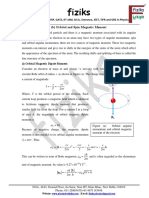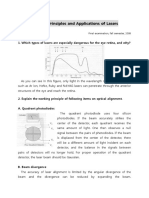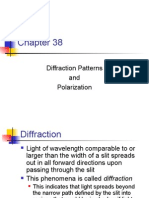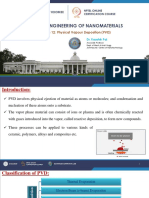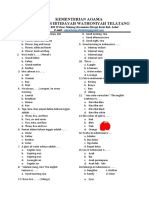Diffraction by Single Slit
Uploaded by
KokeiliewDiffraction by Single Slit
Uploaded by
KokeiliewDIFFRACTION BY SINGLE SLIT
Diffraction : Phenomena where light or waves being spread to a wider region
after its passes through narrow slit or narrow opening.
NEXT
Diffraction of waves
As the width of slit increase, the dispersion of wave decrease.
As the wave length decrease, the dispersion of wave decrease.
The diffraction is appreciable when the width of slit is comparable to the wavelength of the
waves and very small when the width is large compare to wavelength.
NEXT
FRAUNHOFER DIFFRACTION
When parallel light rays incident on a narrow rectangular slit ( width ~ 0.01mm). Light will
be disperse to a region bigger than the width of the slit. This phenomena is called
Fraunhofers Diffraction.
O
When parallel light rays reaches the slit,
each point on the wave front acts as a
secondary coherent source, sending out
new waves beyond the slit. From principle
of superposition, overlapping of coherent
wave front produce diffraction pattern in
front of the slit.
By putting a screen in front, the diffraction pattern consists of dark
and bright fringes:
(a) A bright fringes is obtain at point O.
(b) Other bright fringes with decreasing intensity.
(c) Dark fringes located in between 2 bright fringes. m = 1, 2
m=2
m=1
m=-1
m=-2
NEXT
DIFFRACTION AT SINGLE SLIT
(A) Central bright band:
With O is the central of the diffraction image, a bright band is obtain at O.
Assuming the slit is divided into 2 equal section, each point source
pairing with its corresponding point source, acting as 2 coherent point
sources, producing waves overlap at O with zero path different.
All waves arrive in phase at O, producing a center bright band with maximum
intensity.
The point O is directly in front of the slit, u = 0.
o
NEXT
(B) First minimum: (Dark fringe)
The slit is divided into 2 equal halves.
The top point source of the upper half and
the top point source of the lower half send out
waves to Q, with path difference /2, therefore
the waves overlap out of phase at Q.
All other pairs of corresponding points in
the 2 halves also have path difference /2 and
overlap out of phase at Q.
Therefore, the resultant amplitude at Q is
zero, having zero intensity, (dark fringe).
Point Q also know as the edge of central
bright band.
DIFFRACTION AT SINGLE SLIT
/2
/2
u
1
d
u
1
If u
1
is the direction of first minimum:
Then , d sin u
1
=
For small angle, ( in radian):
u
1
= /d
Q
Q
NEXT
SECONDARY FRINGES
Other than the central bright band and first minimum, other secondary bright
and dark fringes also obtained on the screen beyond Q.
For secondary bright fringes:
Assuming the slit is divided into 3, 5,7 equal
section.
Each consecutive parts have path difference of
, give rise to zero resultant.
The last remaining section give rise to bright
fringes of less intensity. (Calculation show that the First
maximum is only about 5% of the central bright band.)
Equation for the position of secondary bright
fringes:
d sin u
n
= (n + )
For secondary dark fringes: (zero intensity)
Assuming the slit is divided into 2,4,5 equal
section.
Each consecutive parts have part difference of
give rise to zero resultant.
Therefore, the final resultant is also zero.
Equation for position of dark fringes:
d sin u
n
= n
where n = 1,2,3,4,.
NEXT
Half angular width of center bright band
For first minimum: d sin u
1
= , [u
1
= /d if u
1
small in radian, <10
-3
]
Half angular wide of center bright band = u
1
Half width = L tan u
1
Width of center bright band = 2L tan u
1
O-center bright band
m=2
m=1
m=-1
m=-2
u
1
L
NEXT
VARIATION IN DIFFRACTING PATTERN
1. When width of the slit increase, the dispersion of light decrease and the width of the
diffraction pattern decrease but intensity of center bright band increase. [sin u o1/d]
2. When width of slit decrease, the dispersion of light increase, the width of the diffraction
pattern increase but intensity of center bright band decrease.
3. When the slit become too wide, the dark and bright fringes become too close to be seen
by naked eye. So dispersion of light (diffraction of light) disappear.
Sin
-1
/d Sin
-1
2/d Sin
-1
2/d Sin
-1
/d Sin
-1
/d Sin
-1
/d Sin
-1
2/d Sin
-1
2/d
NEXT
Intensity
Intensity
Graph of variation in intensity for diffraction pattern
Example
A rectangular slit of width 0.02 mm is placed in front of a parallel light of wavelength 600nm. A
screen is placed a distance 60 cm from the slit.
Find (a) half angular width of the diffraction pattern form on the screen.
(b) the width of the centre bright fringes.
(c) the half angular width if the width is reduced to 0.3 mm
' o
2 -
3
9 -
43 1
10 x 3
10 02 . 0
600x10
sin
, sin d From (a)
=
=
=
=
u
u
u
x
cm 3.6
) 43 tan(1 60 x 2
tan 2L fringes bright center of Width ) (
' o
=
=
= u b
rad
x
3 -
3 -
3
9 -
10 x 2
10 x 2
10 3 . 0
600x10
sin
, sin d From (c)
~
=
=
=
u
u
u
u
NEXT
Resolving power of Optical Instrument
When light entering the objective lens of an optical instrument, (e.g Telescope)
Diffraction of light occur, produce diffracting pattern for each of the image form.
Angular separation of object: Angle between both object subtended at the optical
center of the objective lens.
o
Image, 1
Image, 2
NEXT
x
L
o
Rayleigh Criteria: 2 images is perfectly resolved when the center maximum of the one fall
onto the first minimum of the other image.
Resolving power of Optical Instrument
Perfectly resolved Totally resolved not resolved
With, D sin u = 1.22 , [ factor 1.22 because of round opening]
sin u = 1.22 / D , [ D- diameter of objective lens]
NEXT
CONDITION FOR PERFECTLY RESOLVED
From Rayleigh criteria: Two images is perfectly resolved when maximum of
one image fall on the first minimum of the other image.
Angle subtended by images at objective lens:
D sin u = 1.22
[ 1.22 is a factor to correct the round opening of the lens]
Perfectly resolved
u
NEXT
o
Image, 1
Image, 2
With tan o = x/L, L- distance of object from lens.
x - distance separation of 2 object.
L
x
And, sin u = 1.22 /D, angle of perfectly resolved.
When o > u, then the 2 image form is totally resolved.
When o < u, then the 2 images is not resolved.
When o = u, the 2 images is perfectly resolved.
Therefore:
The resolving power of optical instrument directly proportional to 1/u.
The bigger the value of D, the higher the resolving power.
NEXT
Resolving Power of Optical Instrument
Example
2 object with separation of 2 mm is located 50 m from the objective lens of a
telescope. If the lens have diameter D, determine whether the image form can be
resolved or not, when
(i) D = 20 cm
(ii) D = 40 cm
rad
x
5 -
5
10 x 4
10 4
50
002 . 0
L
x
tan
=
= = =
o
o
o
50 m
2 mm
resolved. not is images 2 the , Since
. 10 x 3.66
10 x 3.66
10 x 20
10 x 600 x 1.22
sin
6 -
5 -
2 -
-9
u o
u
u
<
=
= =
rad
resolved. totally is images 2 the , ,
. 10 x 1.83
10 x 1.83
10 x 40
10 x 600 x 1.22
sin
6 -
5 -
2 -
-9
u o
u
u
>
=
= =
Since
rad
NEXT
Example
A Youngs double slit, each slit have width 0.04mm and separation 2mm. Monochromatic light of
wave length 580 nm fall on the 2 slits produce an interference pattern on screen placed 90 cm in
front of the slits.
(i) Determine the angular separation between 2 successive bright fringes.
(ii) If one of the slit is covered with an opaque material, find the half angular width of the center
bright fringes form on screen.
. 10 x 2.9
10 9 . 2
10 2
10 x 580
sin
: sin a From (i)
4 -
4
3
9 -
rad
x
x
=
= =
=
u
u
u
49'
10 45 . 1
10 04 . 0
10 x 580
sin
: sin d From (i)
2
3
9 -
=
= =
=
u
u
u
x
x
NEXT
EXERCISE
1. A single slit is located at infinity in front of a lens of focal length 1.0 m and is illuminated normally
with light of wavelength 600 nm. The first minima on either side of the central maximum of the
diffraction pattern observed in the focal plane of the lens are separated by 4 mm. What is the
width of the slit ? [a = 0.3mm]
2. A parallel beam of blue light (420nm) incident on a small aperture. After passing through the
aperture, the beam is no longer parallel but diverges at 1
0
to the incident direction. What is the
diameter of the aperture ? [12m]
3. The headlights of a distant automobile are 1.4 m apart. If the diameter of the pupil of the eye is
3mm, What is the maximum distance at which the headlight can be resolved ? [7.0 km]
4. Two light sources are viewed by the eye at a distance L = 2500m. The entrance opening of the
viewer
s has a diameter of 3mm. If the eye were perfect, the limiting factor for resolution of the
two sources would be diffraction. How large could the separation of the two light sources and
still have the sources seen as separate entities. [ 0.5m]
5. Monochromatic light from a distant source is incident on a slit 0.800mm wide. On a screen 3.00m
away, the distance from the central maximum of the diffraction pattern to the first minimum is
measure to be 1.80 mm. Calculate the wavelength of the light. [480nm]
6. Parallel rays of green mercury light with a wavelength of 546 nm pass through a slit covering a lens
with a focal length of 40.0cm.In the focal plane of the lens the distance from the central
maximum to the first minimum is 12.0 mm. What is the width of the slit.
7. Red light with a wavelength of 633 nm from a helium-neon laser passes through a slit o.300 mm
wide. The diffraction pattern is observed on a screen 4.0 m away. Define the width of a bright
fringe as the distance between the minima on either side.. (a) what is the width of the central
bight fringes ? (b) What is width of the first bright fringe on either side of the central one.
[16.9mm , 8.44mm]
8. Light with a wavelength of 589nm from a distant source is incident on a slit 0.850 mm wide, and the resulting
diffraction pattern is observed on a screen 2.00 m away. What is the distance between the two dark fringes on
either side of the central bright fringes ?
9. A slit 0.200 mm wide is illuminated by parallel rays of light that has a wavelength of 500 nm. The diffraction pattern is
observed on a screen that is 4.00 m from the slit. What is the distance on the screen from the center of the central
maximum to the first minimum ? [1.00 cm]
10 A diffraction pattern is formed by passing parallel rays of light 500 nm through a slit of 0.250 mm wide. What is the
phase difference between wavelets from the top and bottom of the slit at (a) the center of the central maximum, (b)
the third minimum out from the central maximum ?
m x
nm
x
x
x
x
x
m
x
Single Answer
5 - 9
3 -
3
3 -
3
9
3
9
0
9 -
2
1
9 3 -
1.82x10 d ; 10 546
4 . 0
12x10
D 6
480
3
10 8 . 1
x10 0.8 5.
m 0.5 x ;
10 3
10 600
2500
x
4.
km 7.0 L ;
10 3
10 600
L
1.4
. 3
12
1 sin 2
420x10
D
maximum. first for condition , sin D 2.
mm. 0.3 a ; 10 600 ) a(2x10 ; sin a . 1
n) diffractio slit ( :
= =
|
|
.
|
\
|
= =
= =
= =
= =
=
= = =
u
u
t |
t |
t |
u u
u u
u u
6 minimum, third
4 minimum, second
2 minimum, first (b)
0 , difference Phase (a) . 10
0 . 1
0.2x10
500x10
x 4 minimum first and bright center between Distance . 9
8 . 2
0.85x10
589x10
x 2 x 2 minimum, first between Distance
;
d
sin , sin d . 8
44 . 8 2.11)x10 - (4.22 x 4 fringe, bright next of Wicth
88 . 16 10 x 2.11 x 4 x 2 fringe, center of Width
. 10 x 2.11 , 10 11 . 2
10 3 . 0
633x10
sin
fringe. bright center the of
dth angular wi half is where , sin d minimium, first For . 7
3 -
9 -
3 -
9 -
5 -
5 -
5 - 5
3
9 -
= A
= A
= A
=
=
|
|
.
|
\
|
=
=
|
|
.
|
\
|
=
= =
= =
= =
= = =
=
cm
mm
mm
mm
rad x
x
You might also like
- Kronig Penny Model: Engineering Physics by Dr. Amita Maurya, Peoples University, Bhopal. Unit 5No ratings yetKronig Penny Model: Engineering Physics by Dr. Amita Maurya, Peoples University, Bhopal. Unit 57 pages
- MUST TO KNOW CC RODRIGUEZ Flashcards - QuizletNo ratings yetMUST TO KNOW CC RODRIGUEZ Flashcards - Quizlet32 pages
- Two Dimensional Electron Gas System (2DEG)No ratings yetTwo Dimensional Electron Gas System (2DEG)16 pages
- Chapter 27 Circuits: Key Contents The Emf Device Single-Loop Circuits Multi-Loop Circuits RC Circuits100% (1)Chapter 27 Circuits: Key Contents The Emf Device Single-Loop Circuits Multi-Loop Circuits RC Circuits30 pages
- Electromagnetic Fields and Waves: Lecture 3 - 4No ratings yetElectromagnetic Fields and Waves: Lecture 3 - 424 pages
- (#3) Direct, Indirect, Ek Diagram, Effective Mass-1No ratings yet(#3) Direct, Indirect, Ek Diagram, Effective Mass-16 pages
- 271 - PH8252 Physics For Information Science - Notes UNIT IV OPTICAL PROPERTIES OF MATERIALS PDF100% (1)271 - PH8252 Physics For Information Science - Notes UNIT IV OPTICAL PROPERTIES OF MATERIALS PDF66 pages
- 14a Plancks Constant Photo Electric EffectNo ratings yet14a Plancks Constant Photo Electric Effect7 pages
- Waves: Ultrasonic Waves: Piezo Electric Generator or OscillatorNo ratings yetWaves: Ultrasonic Waves: Piezo Electric Generator or Oscillator3 pages
- Module-3: Recombination in SemiconductorsNo ratings yetModule-3: Recombination in Semiconductors13 pages
- Class 4 - Module 1 - Matter Waves Abd DG Expt - DR - Ajitha - PHY1701No ratings yetClass 4 - Module 1 - Matter Waves Abd DG Expt - DR - Ajitha - PHY170122 pages
- Measurement of Low Resistance Using Kelvin's Double Bridge: Ex. No: DateNo ratings yetMeasurement of Low Resistance Using Kelvin's Double Bridge: Ex. No: Date3 pages
- Lecture 5 - Radioactivity - 2 - Decay ChainsNo ratings yetLecture 5 - Radioactivity - 2 - Decay Chains30 pages
- Chapter 2: X-Ray, Neutron, and Electron Diffraction in Crystals100% (1)Chapter 2: X-Ray, Neutron, and Electron Diffraction in Crystals10 pages
- Surface Engineering of Nanomaterials: Lecture 12: Physical Vapour Deposition (PVD)No ratings yetSurface Engineering of Nanomaterials: Lecture 12: Physical Vapour Deposition (PVD)19 pages
- 1 250+ TOP MCQs On Classification of Metals, Conductors and Semiconductors - Class12 Physics 2023No ratings yet1 250+ TOP MCQs On Classification of Metals, Conductors and Semiconductors - Class12 Physics 20239 pages
- BPHY101L-Module2-Lectureppt-Electromagnetic WavesNo ratings yetBPHY101L-Module2-Lectureppt-Electromagnetic Waves42 pages
- Economic Methodology Is The Study of MethodsNo ratings yetEconomic Methodology Is The Study of Methods18 pages
- Pediatrics PreTest Self Assessment and Review Twelfth Edition Robert Yetman - The ebook in PDF format is ready for immediate access100% (1)Pediatrics PreTest Self Assessment and Review Twelfth Edition Robert Yetman - The ebook in PDF format is ready for immediate access50 pages
- Grade 8 Study List Term 3 Final Exam ZehranNo ratings yetGrade 8 Study List Term 3 Final Exam Zehran11 pages
- Consequences of Global Warming:: 1. Melting of Glaciers: The Melting of Glaciers Will Create Plethora ofNo ratings yetConsequences of Global Warming:: 1. Melting of Glaciers: The Melting of Glaciers Will Create Plethora of5 pages
- Instant download (Ebook) Antennas for All Applications by John D. Kraus, Ronald J. Marhefka ISBN 9780072321036, 9780071122405, 0072321032, 0071122400 pdf all chapter100% (4)Instant download (Ebook) Antennas for All Applications by John D. Kraus, Ronald J. Marhefka ISBN 9780072321036, 9780071122405, 0072321032, 0071122400 pdf all chapter86 pages
- NTH Full Cuticle Remy Hair Extension Price List 0611 (2024!06!18 01-02-45)No ratings yetNTH Full Cuticle Remy Hair Extension Price List 0611 (2024!06!18 01-02-45)16 pages
- Lecture - 1 - Molecular Structure of Skeletal Muscle and Function of Nerve-Muscle JunctionNo ratings yetLecture - 1 - Molecular Structure of Skeletal Muscle and Function of Nerve-Muscle Junction16 pages
- Stephanie Paladino (Editor), Shirley J Fiske (Editor) - The Carbon Fix - Forest Carbon, Social Justice, and Environmental Governance-Routledge (2016)No ratings yetStephanie Paladino (Editor), Shirley J Fiske (Editor) - The Carbon Fix - Forest Carbon, Social Justice, and Environmental Governance-Routledge (2016)356 pages
- Chemistry Equilibrium Reactions Which Factor Influences The Value of The Equilibrium Constant For A Reversible Reaction?No ratings yetChemistry Equilibrium Reactions Which Factor Influences The Value of The Equilibrium Constant For A Reversible Reaction?10 pages
- Kronig Penny Model: Engineering Physics by Dr. Amita Maurya, Peoples University, Bhopal. Unit 5Kronig Penny Model: Engineering Physics by Dr. Amita Maurya, Peoples University, Bhopal. Unit 5
- Chapter 27 Circuits: Key Contents The Emf Device Single-Loop Circuits Multi-Loop Circuits RC CircuitsChapter 27 Circuits: Key Contents The Emf Device Single-Loop Circuits Multi-Loop Circuits RC Circuits
- (#3) Direct, Indirect, Ek Diagram, Effective Mass-1(#3) Direct, Indirect, Ek Diagram, Effective Mass-1
- 271 - PH8252 Physics For Information Science - Notes UNIT IV OPTICAL PROPERTIES OF MATERIALS PDF271 - PH8252 Physics For Information Science - Notes UNIT IV OPTICAL PROPERTIES OF MATERIALS PDF
- Waves: Ultrasonic Waves: Piezo Electric Generator or OscillatorWaves: Ultrasonic Waves: Piezo Electric Generator or Oscillator
- Class 4 - Module 1 - Matter Waves Abd DG Expt - DR - Ajitha - PHY1701Class 4 - Module 1 - Matter Waves Abd DG Expt - DR - Ajitha - PHY1701
- Measurement of Low Resistance Using Kelvin's Double Bridge: Ex. No: DateMeasurement of Low Resistance Using Kelvin's Double Bridge: Ex. No: Date
- Chapter 2: X-Ray, Neutron, and Electron Diffraction in CrystalsChapter 2: X-Ray, Neutron, and Electron Diffraction in Crystals
- Surface Engineering of Nanomaterials: Lecture 12: Physical Vapour Deposition (PVD)Surface Engineering of Nanomaterials: Lecture 12: Physical Vapour Deposition (PVD)
- 1 250+ TOP MCQs On Classification of Metals, Conductors and Semiconductors - Class12 Physics 20231 250+ TOP MCQs On Classification of Metals, Conductors and Semiconductors - Class12 Physics 2023
- Pediatrics PreTest Self Assessment and Review Twelfth Edition Robert Yetman - The ebook in PDF format is ready for immediate accessPediatrics PreTest Self Assessment and Review Twelfth Edition Robert Yetman - The ebook in PDF format is ready for immediate access
- Consequences of Global Warming:: 1. Melting of Glaciers: The Melting of Glaciers Will Create Plethora ofConsequences of Global Warming:: 1. Melting of Glaciers: The Melting of Glaciers Will Create Plethora of
- Instant download (Ebook) Antennas for All Applications by John D. Kraus, Ronald J. Marhefka ISBN 9780072321036, 9780071122405, 0072321032, 0071122400 pdf all chapterInstant download (Ebook) Antennas for All Applications by John D. Kraus, Ronald J. Marhefka ISBN 9780072321036, 9780071122405, 0072321032, 0071122400 pdf all chapter
- NTH Full Cuticle Remy Hair Extension Price List 0611 (2024!06!18 01-02-45)NTH Full Cuticle Remy Hair Extension Price List 0611 (2024!06!18 01-02-45)
- Lecture - 1 - Molecular Structure of Skeletal Muscle and Function of Nerve-Muscle JunctionLecture - 1 - Molecular Structure of Skeletal Muscle and Function of Nerve-Muscle Junction
- Stephanie Paladino (Editor), Shirley J Fiske (Editor) - The Carbon Fix - Forest Carbon, Social Justice, and Environmental Governance-Routledge (2016)Stephanie Paladino (Editor), Shirley J Fiske (Editor) - The Carbon Fix - Forest Carbon, Social Justice, and Environmental Governance-Routledge (2016)
- Chemistry Equilibrium Reactions Which Factor Influences The Value of The Equilibrium Constant For A Reversible Reaction?Chemistry Equilibrium Reactions Which Factor Influences The Value of The Equilibrium Constant For A Reversible Reaction?





































